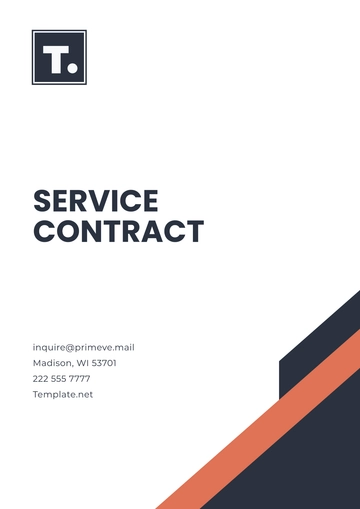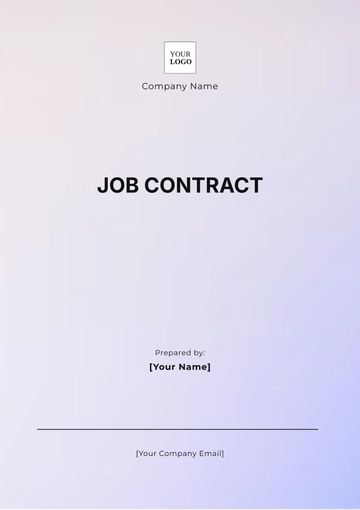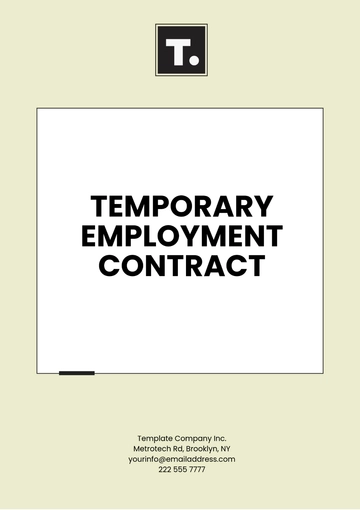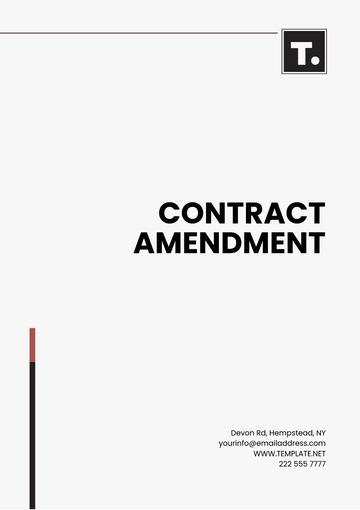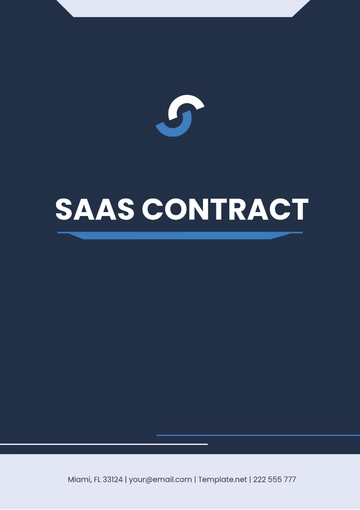Free Sales Comprehensive Analysis of Annual Contracts
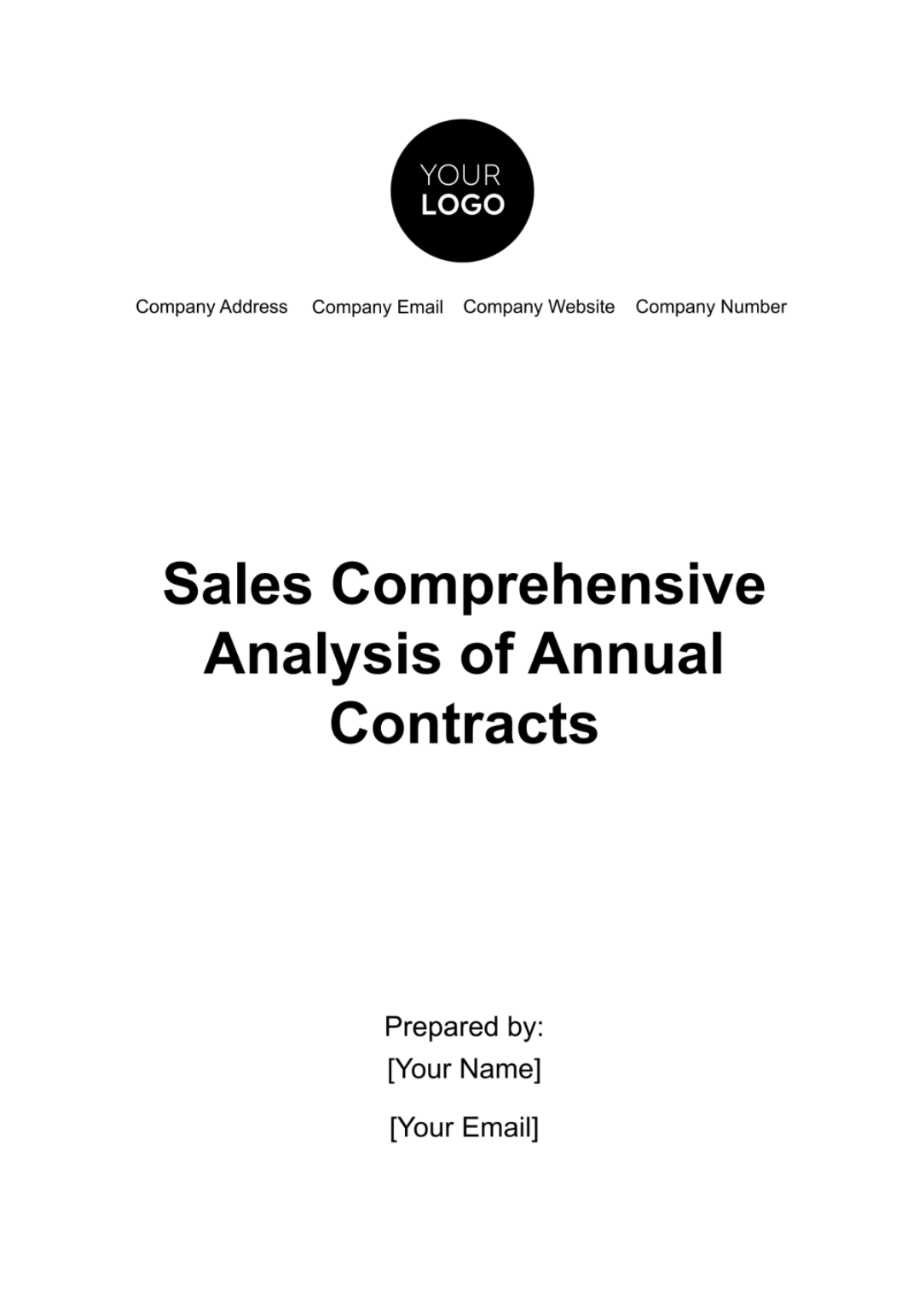
I. Executive Summary
In this comprehensive analysis, we delve into the intricate landscape of our annual contract sales for the year 2053. This extensive examination scrutinizes every facet of our sales performance, offering in-depth insights into crucial dimensions such as revenue, product categories, customer segments, and geographical regions. The primary objective of this analysis is to furnish a robust foundation of understanding, shedding light on our business's inherent strengths, vulnerabilities, potential avenues for growth, and imminent threats. These insights are invaluable, serving as the compass by which we navigate and chart the course of our future strategies.
II. Revenue Analysis
Total Annual Revenue: $500,000
Revenue Growth: Percentage Increase compared to 2052.
Explanation of Revenue Trends:
The assessment of our annual revenue for 2053 reveals both positive and challenging aspects of our financial performance compared to the preceding year, 2052.
A. Positive Trends
Product Innovation: The introduction of innovative products and styles in our portfolio has attracted new customers and increased the average transaction value among existing customers.
Customer Retention: Our focus on enhancing customer experience and engagement has led to a significant increase in customer retention rates, resulting in repeat purchases and consistent revenue streams.
Digital Expansion: Investments in our online presence, including e-commerce enhancements and social media marketing, have expanded our reach and driven online sales, contributing substantially to revenue growth.
B. Challenges
Supply Chain Disruptions: Global supply chain disruptions and shipping delays have occasionally led to product shortages and increased costs, affecting our revenue margins.
Market Competition: The competitive landscape in the fashion industry remains intense. The necessity to adapt pricing strategies to remain competitive has, at times, impacted our profit margins.
Economic Uncertainties: Economic uncertainties and fluctuations in consumer spending patterns have required agile adjustments to our sales and marketing strategies.
While our revenue growth for 2053 demonstrates significant progress, we remain vigilant to the challenges posed by market dynamics. The positive trends are largely attributed to our proactive approach to product innovation and customer engagement, while the challenges underscore the need for supply chain resilience and adaptive pricing strategies. These insights will guide our revenue-focused strategies for the upcoming year.
III. Product Category Analysis
A. Top-Selling Product Categories
Category 1: Men's Casual Wear
Category 2: Women's Activewear
Category 3: Outerwear
B. Performance Insights
Men’s Casual Wear
Growth: Category 1 exhibited remarkable growth in 2053, with a 10% compared to the previous year. This can be attributed to a combination of popular trends, effective marketing campaigns, and strong customer demand.
Margins: The profit margins for Category 1 remained healthy, primarily due to optimized sourcing strategies and efficient inventory management. Our ability to command premium pricing for certain products in this category contributed to strong margins.
Challenges: One notable challenge in Category 1 was managing fluctuations in raw material costs, which occasionally squeezed margins. Additionally, maintaining the pace of innovation to stay ahead of competitors was an ongoing concern.
Women's Activewear
Growth: Category 2 experienced moderate growth in 2053, with a 50% compared to the previous year. While this category is well-established, it faces competition from both traditional and online retailers.
Margins: Margins in Category 2 were stable, primarily due to effective cost management and supply chain optimization. However, pricing pressure from competitors required careful pricing strategies to maintain profitability.
Challenges: The challenge in Category 2 was primarily related to staying relevant in a rapidly changing fashion landscape. Adapting to evolving consumer preferences and trends while managing inventory efficiently was crucial.
Outerwear
Growth: Category 3 saw steady growth, with a 20% compared to the previous year. This category includes some niche products that appeal to a specific target market, contributing to consistent but modest growth.
Margins: Margins in Category 3 were respectable, supported by the premium nature of the products. Limited competition in this niche allowed for better pricing control and margin preservation.
Challenges: The primary challenge in Category 3 was scaling growth without diluting the exclusivity of the products. Maintaining a balance between expansion and preserving the brand's exclusivity was a key consideration.
A diversified product portfolio contributed to our overall revenue growth in 2053. Category 1 stood out as a growth leader, while Category 2 maintained stability in a competitive market, and Category 3 capitalized on niche market appeal. Addressing challenges in each category will be critical in our product category strategies for the coming year, with a focus on innovation, cost management, and pricing strategies.
IV. Customer Segment Analysis
Fashion Enthusiasts (Segment 1):
Acquisition: Segment 1 comprises our fashion-forward customers who are trend-conscious and actively seek the latest styles. They often discover our brand through fashion magazines, influencer collaborations, and social media campaigns.
Retention: Fashion Enthusiasts exhibit strong retention rates due to our consistent delivery of on-trend apparel and personalized recommendations. Our VIP loyalty program, offering exclusive previews and discounts, has been particularly effective in retaining these customers.
Profitability: This segment is highly profitable as Fashion Enthusiasts are willing to invest in premium fashion. They often purchase full-price items and are early adopters of new collections, contributing significantly to our overall margins.
Weekend Casual Shoppers (Segment 2):
Acquisition: Segment 2 represents customers who prefer comfortable and casual clothing for leisure activities. They often discover our brand through online search, social media ads, and word-of-mouth from friends.
Retention: While retention in this segment is moderate, there's potential for improvement. Implementing targeted email campaigns and special promotions for weekend wear has been effective in encouraging repeat purchases.
Profitability: Weekend Casual Shoppers offer good profitability. They appreciate quality casual wear, and while price-conscious, they value durability and style, which aligns with our brand's offerings.
Occasional Shoppers (Segment 3):
Acquisition: Segment 3 represents customers who shop with us on special occasions such as weddings, holidays, or events. They discover our brand through online advertisements, search engines, and referrals from event planners.
Retention: Retention in this segment is a challenge as these customers typically make infrequent purchases. Implementing targeted follow-up communication and event-specific collections can enhance retention.
Profitability: Profitability varies in this segment. While some customers seek high-end event attire, others prioritize budget-friendly options. Efficient inventory management is crucial in optimizing profitability in this segment.
These top customer segments demonstrate the diverse nature of our customer base. Fashion Enthusiasts drive significant revenue and profits, while Weekend Casual Shoppers offer a stable customer base. Occasional Shoppers represent a unique market segment that requires specialized strategies to foster loyalty and profitability. Understanding and catering to these segments will inform our customer-centric strategies for the upcoming year.
V. Geographic Sales Analysis
A. West Coast (Region 1):
Sales Trends: The West Coast, represented by Region 1, has consistently demonstrated robust sales growth throughout the year. Sales in this region have increased by [percentage increase] compared to the previous year. This growth can be attributed to a combination of factors, including the presence of our flagship stores in major cities and effective local marketing campaigns.
Market Penetration: Our brand has established a significant market share in the West Coast, thanks to its well-recognized and respected reputation. Customers in this region often identify with our brand's values and style, contributing to strong brand loyalty.
Opportunities: Despite the impressive performance, there are opportunities for further growth. Leveraging digital channels to complement physical store sales, exploring collaborations with local influencers, and expanding our product offerings to cater to diverse customer preferences are avenues for continued success in Region 1.
B. Midwest (Region 2):
Sales Trends: Region 2, covering the Midwest, experienced moderate sales growth in 2053. Sales increased by [percentage increase] compared to the previous year, with fluctuations influenced by economic factors and seasonal trends. Notably, certain product categories, such as winter wear, performed exceptionally well during colder months.
Market Penetration: Our brand has established a solid presence in the Midwest, but there is untapped potential for growth. The key to success lies in diversifying marketing efforts and aligning them with regional trends and cultural events.
Opportunities: To capitalize on opportunities in Region 2, we plan to invest in localized marketing strategies that resonate with the Midwest audience. Emphasizing seasonally relevant products, exploring partnerships with local influencers, and participating in regional events will be part of our growth strategy.
C. Southeast (Region 3):
Sales Trends: Region 3, encompassing the Southeast, showed steady sales growth throughout the year. Sales increased by [percentage increase] compared to the previous year, primarily driven by online sales channels and targeted digital marketing campaigns. This region boasts a tech-savvy customer base that responds well to e-commerce offerings.
Market Penetration: While our brand has made significant strides in Region 3, there is ample room for expansion. Online sales have been particularly strong, but a hybrid approach, combining online and physical retail presence, can help cater to a diverse customer demographic.
Opportunities: The key opportunities in Region 3 involve expanding our online presence further, optimizing the user experience on our e-commerce platforms, and exploring partnerships with prominent online marketplaces and digital influencers to increase brand visibility in this tech-savvy market.
The top-performing regions exhibit varying sales trends and opportunities. The West Coast (Region 1) benefits from a strong physical presence and customer loyalty. The Midwest (Region 2) shows potential for growth through localized strategies. The Southeast (Region 3) offers significant opportunities in online sales and digital marketing. These insights will shape our regional strategies for the upcoming year, emphasizing both physical and digital channels to maximize market penetration and capitalize on emerging opportunities in each region.
VI. Annual Contract Review
The following table provides a snapshot of key client contracts, highlighting their respective contract values, renewal rates, and significant points of engagement. These agreements signify strategic partnerships and collaborative efforts aimed at fostering long-term relationships and mutual growth between our organization and esteemed clients across diverse industries.
Client | Contract Value | Renewal Rate | Key Points |
|---|---|---|---|
BBY Retail Group | $2,500,000 | 85% | A long-term supply agreement covering multiple regions |
Star Fashion Outlet | $1,800,000 | 92% | Exclusive partnership for premium clothing line |
Vogue Boutique | $750,000 | 78% | Marketing collaboration for joint promotions and events |
The table below outlines the successes achieved and challenges encountered with key clients, shedding light on our collaborative efforts and strategies to address obstacles while leveraging opportunities. Through proactive communication, strategic planning, and effective problem-solving, we continue to strengthen partnerships and drive mutual success in a dynamic business landscape.
Client | Successes | Challenges |
|---|---|---|
BBY Retail Group | Contributed significantly to annual revenue, consistent monthly orders | Occasional delays due to supply chain disruptions, managed effectively through proactive communication |
Star Fashion Outlet | Boosted sales, enhanced brand visibility through prime in-store displays | Inventory management for seasonal items, resolved through better forecasting and communication |
Vogue Boutique | Drove increased foot traffic to stores and online platforms | Maintaining consistent event schedules and aligning marketing strategies, mitigated through careful planning |
VII. Marketing and Promotion Analysis
The following table provides insights into the return on investment (ROI) and impact of various marketing campaigns implemented within our fashion ecosystem. Each campaign's effectiveness is highlighted, showcasing how strategic initiatives have not only driven revenue growth but also enhanced brand visibility, engagement, and loyalty among our target audience.
Campaign | ROI | Impact |
|---|---|---|
Summer Style Showcase | 5.7x | The "Summer Style Showcase" campaign achieved a remarkable ROI of 5.7x. This campaign highlighted our latest summer collection through diverse channels, resulting in a 20% revenue increase and heightened customer engagement and loyalty. |
Holiday Extravaganza | 4.2x | The "Holiday Extravaganza" campaign generated a notable ROI of 4.2x. This holiday-themed initiative featured special promotions and festive atmospheres, leading to a 25% revenue surge and strengthened brand appeal during the holiday season. |
Content Marketing | 6.1x | Content marketing consistently delivered an impressive ROI of 6.1x. Through valuable fashion insights and guides, we've built a loyal audience, driving both direct sales and enhanced brand loyalty and engagement. |
Influencer Collaborations | 4.8x | Collaborations with fashion influencers yielded a strong ROI of 4.8x. Leveraging their reach and credibility, we expanded our audience, increased sales, and heightened brand visibility, resulting in a surge in social media followers and brand recognition. |
VIII. Conclusion
The comprehensive analysis of our annual contract sales for 2053 has unveiled a wealth of insights into the performance and dynamics of our clothing brand. Delving into the intricacies of our revenue streams, product categories, customer segments, and regional strengths has equipped us with the knowledge needed to steer our brand towards sustained success.
In a competitive clothing market, the ability to adapt and innovate is paramount. The challenges we have identified serve as opportunities for growth, and the successes we have celebrated underscore our brand's resilience and adaptability.
As we look ahead to the coming year, this analysis will be the cornerstone of our strategic planning efforts. It provides us with the guidance required to capitalize on emerging opportunities, mitigate potential threats, and, most importantly, continue to provide our customers with the high-quality clothing and exceptional service they expect from our brand.
For any inquiries, discussions, or collaborative opportunities stemming from this analysis, we welcome you to reach out to us at [Your Company Number]. Together, we will shape the future of our clothing brand, striving for continued growth and excellence in the fashion industry.
- 100% Customizable, free editor
- Access 1 Million+ Templates, photo’s & graphics
- Download or share as a template
- Click and replace photos, graphics, text, backgrounds
- Resize, crop, AI write & more
- Access advanced editor
Unlock the power of data with our Sales Comprehensive Analysis of Annual Contracts Template. Dive deep into your revenue, product categories, customer segments, and regions. Gain insights into what's working and where opportunities lie. Elevate your strategic planning and drive growth in the competitive landscape with our customizable template that is easily editable using Template.net's AI Editor Tool.
You may also like
- Rental Contract
- Contractor Contract
- Contract Agreement
- One Page Contract
- School Contract
- Social Media Contract
- Service Contract
- Business Contract
- Restaurant Contract
- Marketing Contract
- Real Estate Contract
- IT Contract
- Cleaning Contract
- Property Contract
- Supplier Contract
- Partnership Contract
- Food Business Contract
- Construction Contract
- Employment Contract
- Investment Contract
- Project Contract
- Payment Contract
- Student Contract
- Travel Agency Contract
- Startup Contract
- Annual Maintenance Contract
- Employee Contract
- Gym Contract
- Event Planning Contract
- Personal Contract
- Nursing Home Contract
- Law Firm Contract
- Work from Home Contract
- Software Development Contract
- Maintenance Contract
- Music Contract
- Amendment Contract
- Band Contract
- DJ Contract
- University Contract
- Salon Contract
- Renovation Contract
- Photography Contract
- Lawn Care Contract


